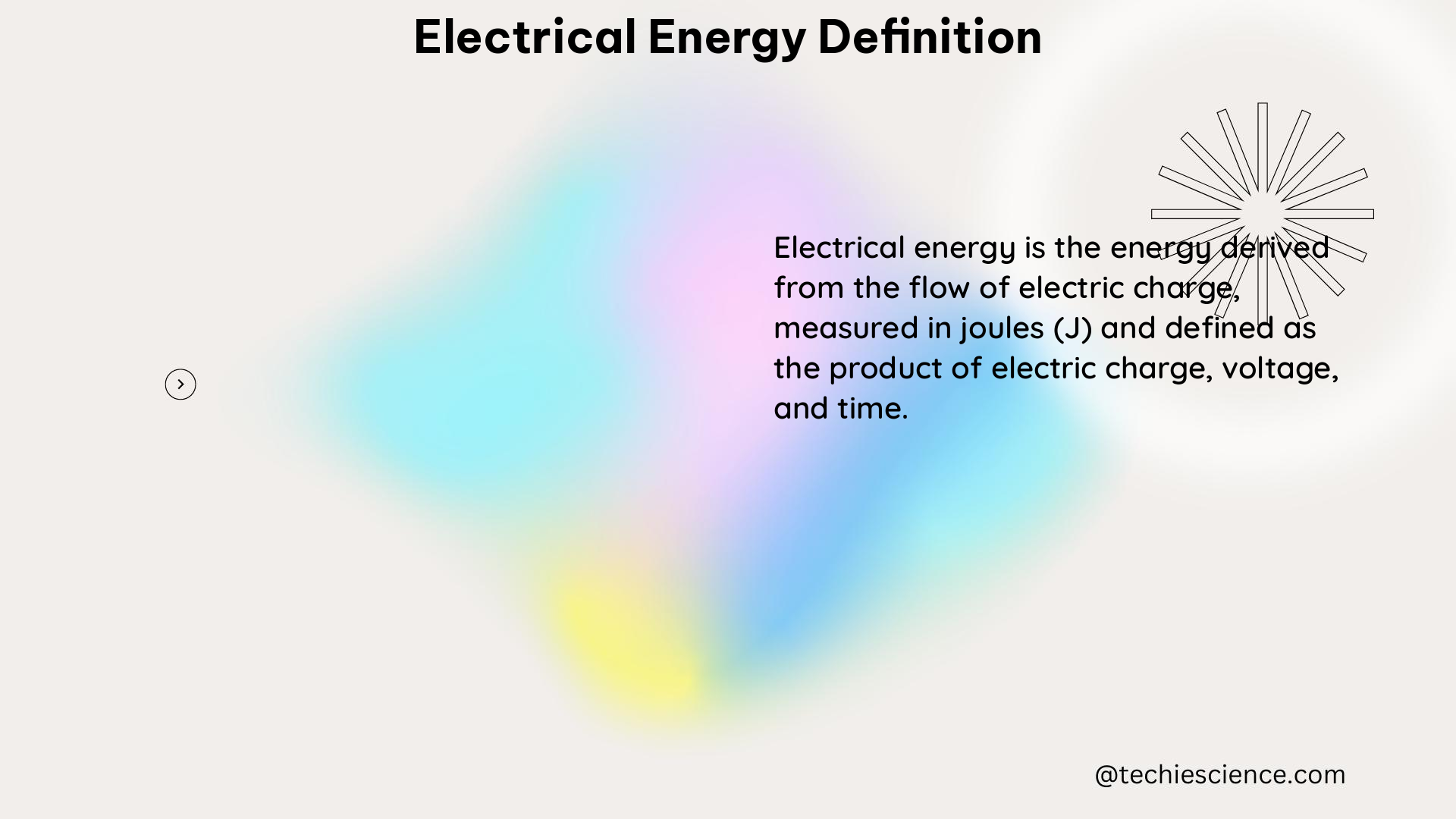Electrical energy is a fundamental form of energy that powers our modern world. It is generated by the movement of charged particles, such as electrons, and is derived from various primary sources like coal, natural gas, or nuclear reactions. This comprehensive guide delves into the intricate details of electrical energy, providing a wealth of technical information and quantifiable data to help you gain a deep understanding of this essential concept.
Definition and Units
Electrical energy is the energy associated with the movement of charged particles, typically measured in Joules (J). The Joule is the standard unit of electrical energy and is defined as the energy expended when a force of 1 Newton is applied over a distance of 1 meter.
The mathematical expression for electrical energy (E) is:
E = Q × V
Where:
– E is the electrical energy in Joules (J)
– Q is the electric charge in Coulombs (C)
– V is the electric potential difference in Volts (V)
This equation demonstrates the relationship between the amount of electric charge, the potential difference, and the resulting electrical energy.
Energy and Power

Electrical energy is the total amount of work done by an electric current over a period of time. It is typically measured in Joules (J). On the other hand, electrical power is the rate at which electrical energy is transferred, and it is measured in Watts (W), which is defined as 1 Joule per second (J/s).
The mathematical expression for electrical power (P) is:
P = V × I
Where:
– P is the electrical power in Watts (W)
– V is the electric potential difference in Volts (V)
– I is the electric current in Amperes (A)
This equation highlights the connection between voltage, current, and the rate of energy transfer, which is essential for understanding the efficient use and distribution of electrical energy.
Examples and Applications
Light Bulb
A 100-Watt light bulb uses 100 Joules of electrical energy per second, transforming it mostly into thermal energy and a small portion into visible light. The efficiency of the light bulb can be calculated as the ratio of the luminous energy output to the electrical energy input.
Data Centers
The power usage effectiveness (PUE) metric is used to measure the energy efficiency of data centers. A PUE of 1.0 indicates that the computing equipment uses nearly all the energy, while a PUE of 2.0 means an additional watt of IT power is required to cool and distribute power to the IT equipment for every watt of IT power used.
Energy Efficiency
Energy Proportionality
Energy proportionality is a concept that measures the relationship between the power consumed by a computer and the rate at which it performs useful work. This is an important consideration for designing energy-efficient systems, as it helps identify and minimize energy waste.
Power Usage Effectiveness (PUE)
PUE is a widely used metric for measuring the energy efficiency of data centers. It is calculated by dividing the total facility power by the IT equipment power. A lower PUE value indicates a more energy-efficient data center.
Energy Consumption
Load Inventory
A load inventory is a process that produces quantified estimates of a facility’s electricity load and consumption. This information is crucial for analyzing the demand and supply of electrical energy, enabling better planning and optimization.
Energy Index
An energy index is a measure of energy intensity that helps analyze energy consumption patterns. It is typically expressed as the ratio of energy consumption to a specific metric, such as floor area or production output, allowing for comparative analysis and identification of opportunities for improvement.
Green Software and Energy Efficiency
Energy Efficiency Goal
Green software practitioners aim to consume as little energy as possible, reducing carbon emissions and waste throughout the entire software development and deployment process. This includes optimizing code, hardware, and infrastructure to minimize the energy footprint.
Energy Proportionality in Practice
Techniques like batching jobs together can take advantage of energy proportionality, reducing energy waste and emissions. By understanding the relationship between power consumption and useful work, software developers can implement strategies to improve the overall energy efficiency of their applications.
Conclusion
Electrical energy is a fundamental form of energy that powers our modern world. This comprehensive guide has explored the definition, units, energy and power concepts, examples, energy efficiency metrics, and energy consumption analysis related to electrical energy. By understanding these technical details and quantifiable data points, you can gain a deeper appreciation for the importance of electrical energy and its efficient utilization in various applications.
References
- Scheidt, F. vom Medinová, H., Ludwig, N., Richter, B., Staudt, P., & Weinhardt, C. (2020). Data analytics in the electricity sector – A quantitative and qualitative literature review. Sustainable Energy Technologies and Assessments, 43, 100924. doi: 10.1016/j.seta.2020.100924
- U.S. Department of Energy. (n.d.). Step 2.9 Establish energy performance improvement objectives and targets. Retrieved from https://www1.eere.energy.gov/manufacturing/eguide/foundational_step_2_9.html
- Clean Energy Literacy. (n.d.). Energy is a Physical Quantity. Retrieved from https://cleanet.org/clean/literacy/energy1.html
- USAID. (n.d.). Load and Energy Consumption. Retrieved from https://www.usaid.gov/energy/powering-health/analyze-demand-supply/load-consumption
- Green Software Foundation. (n.d.). Energy Efficiency. Retrieved from https://learn.greensoftware.foundation/energy-efficiency/

I am Subrata, Ph.D. in Engineering, more specifically interested in Nuclear and Energy science related domains. I have multi-domain experience starting from Service Engineer for electronics drives and micro-controller to specialized R&D work. I have worked on various projects, including nuclear fission, fusion to solar photovoltaics, heater design, and other projects. I have a keen interest in the science domain, energy, electronics and instrumentation, and industrial automation, primarily because of the wide range of stimulating problems inherited to this field, and every day it’s changing with industrial demand. Our aim here is to exemplify these unconventional, complex science subjects in an easy and understandable to the point manner.